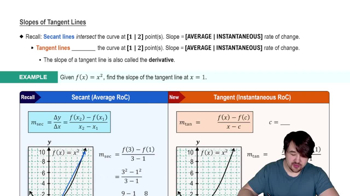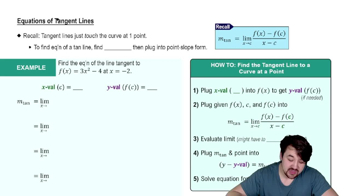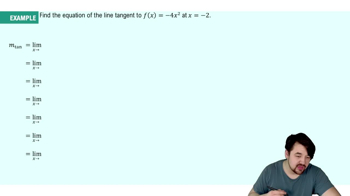Table of contents
- 0. Functions7h 52m
- Introduction to Functions16m
- Piecewise Functions10m
- Properties of Functions9m
- Common Functions1h 8m
- Transformations5m
- Combining Functions27m
- Exponent rules32m
- Exponential Functions28m
- Logarithmic Functions24m
- Properties of Logarithms34m
- Exponential & Logarithmic Equations35m
- Introduction to Trigonometric Functions38m
- Graphs of Trigonometric Functions44m
- Trigonometric Identities47m
- Inverse Trigonometric Functions48m
- 1. Limits and Continuity2h 2m
- 2. Intro to Derivatives1h 33m
- 3. Techniques of Differentiation3h 18m
- 4. Applications of Derivatives2h 38m
- 5. Graphical Applications of Derivatives6h 2m
- 6. Derivatives of Inverse, Exponential, & Logarithmic Functions2h 37m
- 7. Antiderivatives & Indefinite Integrals1h 26m
- 8. Definite Integrals4h 44m
- 9. Graphical Applications of Integrals2h 27m
- 10. Physics Applications of Integrals 2h 22m
2. Intro to Derivatives
Tangent Lines and Derivatives
Problem 3.2.11
Textbook Question
Use limits to find f' (x) if f(x) = 7x.
 Verified step by step guidance
Verified step by step guidance1
Step 1: Recall the definition of the derivative using limits. The derivative of a function f(x) at a point x is given by the limit: f'(x) = \lim_{h \to 0} \frac{f(x+h) - f(x)}{h}.
Step 2: Substitute the given function f(x) = 7x into the derivative definition. This gives us: f'(x) = \lim_{h \to 0} \frac{7(x+h) - 7x}{h}.
Step 3: Simplify the expression inside the limit. Distribute the 7 in the numerator: 7(x+h) = 7x + 7h. So, the expression becomes: \frac{7x + 7h - 7x}{h}.
Step 4: Cancel out the terms in the numerator. The 7x terms cancel each other, leaving: \frac{7h}{h}.
Step 5: Simplify the fraction by canceling h in the numerator and denominator, resulting in 7. Therefore, f'(x) = \lim_{h \to 0} 7 = 7.
 Verified video answer for a similar problem:
Verified video answer for a similar problem:This video solution was recommended by our tutors as helpful for the problem above
Video duration:
1mPlay a video:
Was this helpful?
Key Concepts
Here are the essential concepts you must grasp in order to answer the question correctly.
Limits
Limits are fundamental in calculus, representing the value that a function approaches as the input approaches a certain point. They are essential for defining derivatives, as they allow us to analyze the behavior of functions at specific points, particularly when dealing with continuity and instantaneous rates of change.
Recommended video:

One-Sided Limits
Derivatives
A derivative represents the rate of change of a function with respect to its variable. It is defined as the limit of the average rate of change of the function as the interval approaches zero. In this context, finding f'(x) involves applying the limit definition of the derivative to the function f(x) = 7x.
Recommended video:

Derivatives
Function Notation
Function notation, such as f(x), is a way to express mathematical relationships where 'f' denotes a function and 'x' is the input variable. Understanding function notation is crucial for interpreting and manipulating functions, especially when calculating derivatives or evaluating limits, as it provides clarity on how inputs relate to outputs.
Recommended video:

Sigma Notation

 5:13m
5:13mWatch next
Master Slopes of Tangent Lines with a bite sized video explanation from Nick
Start learningRelated Videos
Related Practice




